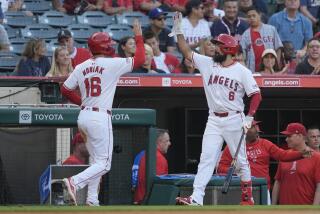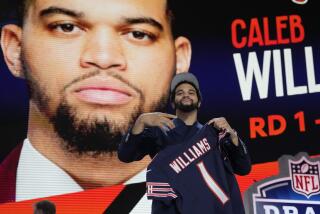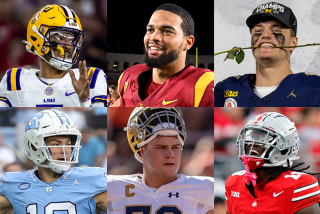Today, NFL Presents Its 50th Draft With Appropriate Fanfare : In 1936, It Wasn’t Such a Big Deal
- Share via
At 5 o’clock this morning, the National Football League began its 50th draft, making it appropriate that we remember for a moment the nine pioneers who held its first.
This would be especially nice, since no one paid any attention to them that day.
It was Feb. 8, 1936. The nine pioneers weren’t spread out all over the country connected by telephone conference hookups, but gathered in a meeting room in the Ritz-Carlton Hotel in Philadelphia. The site was a testimony to the influence of Bert Bell, then owner of the Eagles. So was the fact that they were having a draft.
“Bert Bell was the father of the draft, I would say,” said the Steelers’ Art Rooney, at 84 the lone surviving owner of that era, from Pittsburgh. “It was supposed to help the weaker teams. I don’t know if it did or not. It didn’t seem to help us.”
In a radical innovation, Bell’s plan let teams choose in reverse order of their finish. Guess which team had just finished last? Everyone who said the Eagles, take one step forward.
NFL Commissioner Joe Carr said that the draft would prevent “promiscuous scrambling” for top prospects. Years later, owner George Halas of the Chicago Bears said that he was the one being held responsible for some of the promiscuity, that it was his wild spending sprees that his fellow owners wanted to curb.
The Bears had been a ruling power since the NFL’s inception in 1921 because Halas would pay top dollar, at least when that entailed just three digits. Take his star lineman, Ed Healey. One season Halas, needing a tackle, called up the owner of the Rock Island Independents, who owed him $100, and offered to take Healey in settlement. The rest, of course, is football history, or pre-history. Healey is in the Hall of Fame.
In the first draft, the owners chose from among 90 names that had been chalked up on a blackboard. There wasn’t a lot of media pressure on them. The early Christians didn’t have much more privacy when they were meeting in the catacombs.
The few newspapermen present at the draft sat at the tables next to the men they were covering and helped them pick. When they tried to file stories, their editors told them to keep it short. The New York Times’ coverage of the meeting was three paragraphs, under a headline that said, “Player Plan Is Adopted.” It mentioned no players’ names and said, mistakenly, that the draft would be held at the end of the season. A story on cricket in India was given more prominent play.
The Times ran 10 paragraphs, most of them about a Los Angeles bid for a franchise, under a headline that said, “Six Eastern Pro Grid Teams to Appear Here.” No players’ names were mentioned in that dispatch, either.
The prospective draftees weren’t sitting in their living rooms with minicams rolling every time they picked up the telephone. There was no TV coverage, live, cable or otherwise. Of course, there was no broadcast TV then.
Jay Berwanger, the fancy halfback from the University of Chicago, the first Heisman Trophy winner who also became the NFL’s first pick, didn’t know that a draft was being held, or what one was. He says now that he found out about his selection in the newspapers.
Berwanger didn’t sign a big-money contract or any other kind of contract, either. He said he couldn’t afford it. Instead, he took a $25-a-week job in a rubber company.
“My timing was no good in those days,” said Berwanger, now 71 and a wealthy businessman, laughing from his Chicago office.
Companies at that time had no interest in letting employees take six months off a year to rush the old pigskin. There was still a Depression, jobs were scare and a man needed to grab something he could count on.
Football at that time was dominated by the colleges. The pros paid peanuts. Ivy League stars aspired to jobs in business. The NFL was the province of young men looking for a couple of years of a post-graduate lark, or roughnecks with less chance of obtaining seats on the Wall Street exchanges.
But some things were familiar, too. The forerunners of many current draft day trends were already present:
--Scouting--You can’t have a draft without advance information, and the nine owners had their sources.
“We didn’t do too much scouting,” Rooney says. “You’d buy newspapers. You’d get newspapers from the different cities of the players that you were interested in. You’d buy magazines, things like that. You’d get the Little All-America teams. You (writers) were the scouts.”
That explains everything.
--Combines--It was a little early for BLESTO (Bears Lions Eagles Steelers Talent Organization). The first combine may have been scout Fido Murphy, who worked for both the Bears and Steelers.
Rooney said it was great fun, watching Murphy run back and forth between the Steeler and Bear tables on draft day. If it sounds like a situation rich in conflict-of-interest potential, the only dispute seems to have been a more basic one, over who was to pay Fido.
Rooney said: “George (Halas) had charge of him, in that he was taking care of his expenses and salary. After a year or so, he said it was our turn to do it. He wanted to get the guy off his hands. He had all he could do to keep track of Fido’s financial affairs.”
--Colorful names--The Brooklyn Dodgers drafted Paul (Bear) Bryant, an end from Alabama. He didn’t sign.
Rooney’s first draft pick was halfback William Shakespeare of Notre Dame. He didn’t sign, either.
--Bad drafts--The Eagles, whose owner thought up this whole thing, signed no one.
--The big fish gets away--Long before Tom Cousineau bolted for Canada, or Herschel Walker, Marcus Dupree, Doug Flutie, Mike Rozier, Steve Young et al went to the USFL, there was Berwanger.
Berwanger was big all right. As was the case with Illinois’ Red Grange, college stardom had already made him about as famous as a man could get playing football.
Berwanger was known as the One-Man Team from the University of Chicago--and also, after becoming the first to wear a face guard to protect an injury, The Man in the Iron Mask. A year after he graduated, the Saturday Evening Post asked him to tell his own story.
Berwanger was drafted by the Eagles, who never contacted him and then sold his rights to the Bears, one of his home-town teams. The Bears didn’t sign him, either.
--High-pressure negotiations--You can’t say the Bears didn’t try, though.
“I had indicated all along that I wasn’t particularly interested in playing pro,” said Berwanger.
“I did see George Halas in the lobby of a hotel one night. He asked me what I wanted. Tongue in cheek, I told him, ‘Twenty-five (thousand dollars) for two years, no-cut.’
“I had a date with me and he was with his wife. He said to my date, ‘Nice seeing you. Have a nice time at the parties.’
“I went to work for a rubber company, for $25 a week. I did some other things on the side. I had a column in the Chicago Daily News in the fall, for $100 a week. I coached the freshmen (at the University of Chicago). I made a lot of speeches around. Actually, for the two-year period, I made what I asked Halas for, or a little better.”
Rooney said: “That happened in those days. Five thousand dollars was a big touch for one of those guys. Bronko Nagurski, I didn’t know this, he told me one night at a banquet why he’d quit. He was getting $5,000 and he wanted $6,000. George (Halas) offered $5,500 and he quit playing.”
A lot has happened in 50 years.
Berwanger became a manufacturers’ representative and opened his own firm. In 1971, it was reported to have grossed $10 million. He lives on an estate. He jokes about his timing, but he says he has never really second-guessed himself for not signing. He is the only top pick of an NFL draft who did not go on to play professional football somewhere.
Rooney’s Steelers had a lot more bad drafts, but finally some good ones.
The NFL grew up and blossomed in the day of the coaxial cable, the computer and the cast of thousands. All of those were wonders that they couldn’t have conceived of in 1936, when at least an owner didn’t have to wake up in the middle of the night to divide up some football players.
More to Read
Go beyond the scoreboard
Get the latest on L.A.'s teams in the daily Sports Report newsletter.
You may occasionally receive promotional content from the Los Angeles Times.










